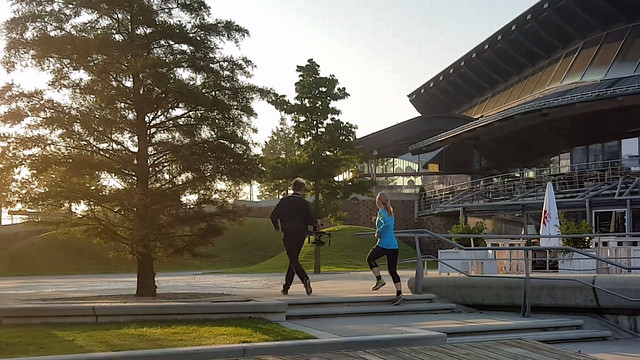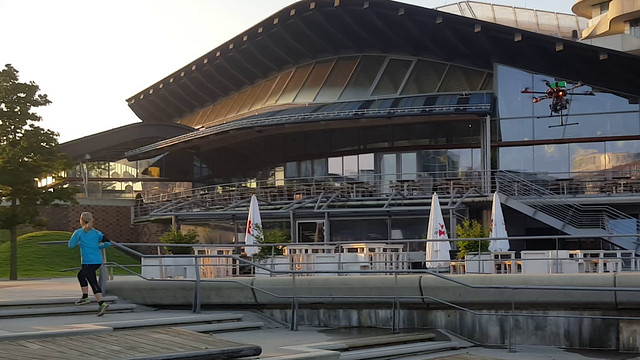(Guest Post) Professional 4K Stabilization for Sony A7RII
The following is a Guest Post on courtesy of kopterkraft.com:
—-
Professional 4K Stabilization for Sony A7RII
In order to get an idea what this article is about, let us first take a look behind the scenes of the final result shown at the end:

Pic. 1: Producing stable content with a handheld gimbal

Pic 2: Recording stabilized aerial footage
For those considering ambitious 4K videos with compact equipment, so far the Lumix GH4 or the Sony A7S have been the cameras of choice during the last year. Both had their downsides: The A7S could deliver 4K UHD only through HDMI for external recorders like the Atomos Shogun which made the combination unhandy for agile applications and too heavy for most multi rotor aerial platforms. The GH4 was able to record 4K internally but the low light performance is quite questionable and due to its 2.6 crop when recording 4K, even a 12 mm lens becomes already 31.2 mm equivalent. The Samsung NX1 was already too bulky for most aerial platforms and suffers from a strong rolling shutter, the NX500 has a crop factor of 2.4 when recording 4K and switches down to 1080p when you connect a device to the HDMI port, which makes it unsuitable for most 4K aerial applications as well. Some users with a higher threshold for pain decided to go with the BMPCC but this has a high crop factor as well and can be used for video solely. All of them did not contain an in body stabilization.
Due to all these shortcomings, I decided to go ahead with the Sony A7S for a while. On the ground, it delivered excellent 4K footage in combination with a Shogun and in the air, it was able to deliver at least quite decent 1080p footage. Due to its light body and some light lenses available like the Zeiss FE 2.8/35 or the Voigtlander Skopar 21/4, it was possible to use it even on multi rotor platforms with a total take-off weight below 5 KG. This is the magic limit in several European countries (e.g. Germany), when you want to fly without particular request for authorization for each single flight.
The major challenge is the unit which is responsible for 3-axis camera stabilization, called “brushless gimbal”. Think of it as an electronic steadycam, using three brushless motors, one or two gyroscopic IMUs (inertial measurement unit) and a controller, driving the motors in order to balance every movement of the camera. We are talking about large amplitude, low frequency movements, which no OIS or IBIS can compensate. You may have heard from MoVI or Ronin M, but those are usually too heavy for aerial applications.
I spent about eight months in several gimbals, controllers and many tuning sessions but even then the results were not completely satisfying. There was still some micro-vibration and shake in the videos and with certain shutter speeds you could notice jello in the pictures. In order to get stable footage with these cameras, most of the users ended up in larger aerial platforms like the DJI S900 with a Zenmuse Z15 gimbal dedicated for that particular camera – breaking the 5 kg limit and getting unflexible regarding choice of camera and lense.
In the meantime the Sony A7RII entered the arena and I decided to put together all my experiences collected about damping and stabilization so far and give it a try. I bought a new gimbal body and applied several modifications to it as well as to the controller in order to make it compatible with the Sony A7RII. I also designed some 3D printable parts for optimized component attachments and also the mount to the aerial platform required several modifications in order to get it stable and minimize vibrations. After all this grief, the first test flight was breathtaking for me, as I did not expect such a big improvement. The video was already embedded earlier at SonyAlphaRumors, so I only recap the link here: https://vimeo.com/135876615
Now, after a lot of paperwork for permissions and some further technical optimizations, the deadline for my next project was approaching. It was titled “Hafencity Runner”, telling a story about a girl regularly in the early dawn running a round in the seaport of Hamburg. It was planned to record some scenes on the ground with handheld gimbal as well as aerial footage – all in 4K with the Sony A7RII:
After publishing these two videos, I got a lot of questions regarding the aerial platform and the gimbal.
- Regarding the multi rotor, I can say that it is based on a foldable Tarot 680pro hexa copter frame. I decided for a hexa because of its advanced safety and redundancy (you usually can safely return and land it even when one of the motors drops out). When you plan to build it close to the 5 kg limit, you should consider a propulsion that is capable to produce enough thrust like the DJI E600 or E800 motor set. It is very important to choose well balanced props.
- Regarding the gimbal, at the moment I do not know any manufacturer providing a ready-to-use lightweight gimbal particularly designed and fine-tuned for the Sony A7RII. I also cannot provide a simple parts list that you can easily shop and assemble. In my case it was a composition of many components from different manufactures and some self-designed constructions created over the last months so that I would call it highly customized, A7RII fine-tuned “KopterKraft” gimbal. It can be easily mounted to a headheld grip as well.
- Finally also the in-body stabilization settings in the A7RII should be set according to the focal length of the attached lens in order to reduce remaining micro vibrations that cannot be eliminated by the gimbal. I recomend the 4K full frame mode of the A7RII because of its significantly lower rolling shutter compared to the Super35 4K mode. The price may be some minor moiré that will disappear when using a proper downscaling algorithm to 1440p or 1080p.
For further information please feel free to contact me at info@kopterkraft.com and visit my website at http://www.kopterkraft.com .


